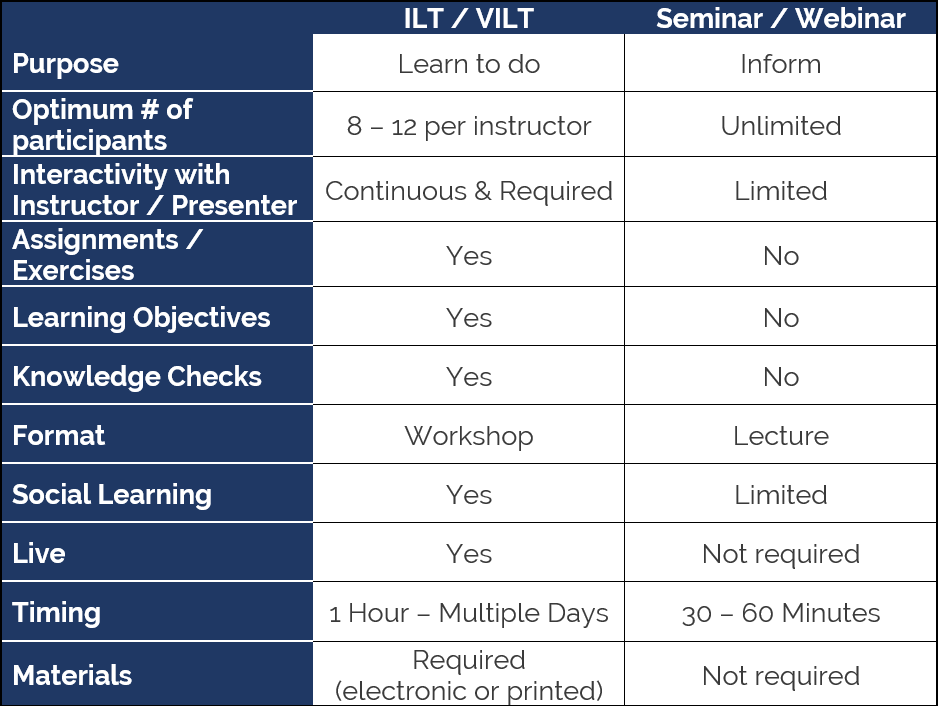Trainers: Do they really know how to do what you just taught them?
Professional trainers know that “Telling Ain’t Training”[i]! If you think the participants in your session learned how to do what you just showed them, you might be surprised to find out that they will remember very little.
Instructor-Led Training vs. Webinar
Instructor-led training [ii], whether in person (ILT), or virtually over the Web (VILT) is an effective Customer Education format, where a “teacher” or “facilitator” helps a group of learners acquire or hone new skills. Typically, sessions have learning objectives so that participants can expect to be able to DO something after the event.
By contrast, webinars [iii] are “seminars or presentations conducted over the Internet.” They are typically shorter and include far less interaction. There is no expectation that participants will acquire new skills.

Prepare for Training Success
Effective ILT requires connection and interaction. Even when you know your subject, it requires extra preparation.
What do you need to know to be an effective trainer?
- Know the subject
- Know the audience
- Apply the subject to what the audience is trying to achieve
1. Know the material well enough that it comes from your heart
A well-designed training curriculum has a logical flow that you should know inside out. However, you need to be prepared to take questions that might take you off topic and perhaps out of order. Know it well enough that you can get back to the topic. Remember, many learners want to follow along with the written text. So, follow the agenda as closely as possible.
2. Learn about your audience before each new session
How do you get over the boredom of teaching the same thing thousands of times? INTERACT! Your participants are all different (in the virtual world, they are coming from vastly different locations). Use the same techniques method actors do to emotionally identify with your participants.
Prepare separately for each presentation. Learn about the participants and imagine how they might use the tool/process to solve their potential challenges. This will keep the experience fresh for you and make the participants feel valued and more able to engage.
Yes, this can take a bit of time, but the reward for everyone is worth it! Use Internet resources like LinkedIn® or Facebook® to learn what you can about your audience. Even if you teach the same type of professional clientele (say salespeople), you can use this information to make the class more personal.
3. Prepare the logistics
Whether in-person or in a virtual classroom, be in the room early to set up. Have your slides, virtual and physical environments ready to go. Kassy LaBorie [iv] reminds trainers to:
- Greet people as soon as they join.
- Use their names.
- Ask them to unmute and say hello.
- Wave to them on camera.
- Participate in a warmup activity.
- Start on time!
Teach so they will learn
Finally, it is time to teach! There are tried and true methods to ensure your participants leave your session with the skills you have told them they would learn.
1. Tailor the content for the group
You don’t have to change the written content for each group. Instead present with your participants’ stories in mind.
Remember
- Participants’ time is valuable.
- Participants need to leave being able to do something that will improve their…
- Business
- Processes
- Results
2. Explain the Context
Bill Cushard [v] reminds us if you want learners to stop “checking their phones,” you need to explain how learning the software relates to what they need to accomplish. Encourage interactions. Use the information you know about your participants to tell their stories.
3. Demonstrate the task
Demonstrate the task, slowly, and describe each step so your learners can follow what you are doing.
This is the part that most trainers seem to be born to do. However, make sure that as you show, you:
- Start with an overview of the user interface and how to find the tools they will need.
- Show them how to solve their own problems [vi] by showing them how to:
- Get help
- Go back a screen
- Get out of the application
- Explain how they can find instructions if they don’t follow each step.
- Demo using examples that are relevant to them.
- Take it slowly.
For a learner, missing one step can create havoc. - Allow for questions.
Software changes how people do their jobs. Often questions during class give you insights, use cases for your product, and new best practices.
4. Provide practice exercises.
Give students a step-by-step guide to practice what you have just demonstrated. This step requires a good instructional design.
Whether you provide a sandbox, simulations, or other ways to do the exercises, learners must “deliberately practice [vii]” the task to learn it well. They also need a chance to learn by doing and fixing their own mistakes.[viii] And, while class limits repetition, students should have time to practice the skill correctly the first time, and to get help when they get stuck.
5. Review the process at the end of each section.
Wrap up each module with a brief review of what was learned and how it applies to the overall process they are learning.
While more learning is available in self-serve modules, instructor-led training will never go away. When done right, social interactions and participation in a live (virtual) classroom are an invaluable way to learn skills in person and virtually.
Download pdf version.
Got questions about your Customer Education program? Book a free Customer Education strategy session.

References
[i] Stolovitch, Harold D. and Keeps, Erica J. (2011) https://www.td.org/books/telling-aint-training-2nd-edition
[ii] Instructor-led training (2020, November 18) In Wikipedia. https://en.wikipedia.org/wiki/Instructor-led_training
[iii] Webinar. In Dictionary.com. Retrieved December 7, 2020, from https://www.dictionary.com/browse/webinar?s=t
[iv] LaBorie, Kassy. Virtual Training Hero Tip #20. (2020. June 21). https://kassyconsulting.com/2020/06/21/virtual-training-hero-tip-20/
[v] Cushard, Bill (2015. June 4). https://blog.servicerocket.com/adoption/blog/2015/06/4-ways-to-make-teaching-complex-software-easier
[vi] Kapp, Karl. Tips for Teaching Software to Others. (2007. August 22). http://karlkapp.com/tips-for-teaching-software-to-others/
[vii] Ericsson, K. Anders. and Harwell, Kyle W. Deliberate Practice and Proposed Limits on the Effects of Practice on the Acquisition of Expert Performance: Why the Original Definition Matters and Recommendations for Future Research. (2019. October 25). https://www.frontiersin.org/articles/10.3389/fpsyg.2019.02396/full
[viii] Slade, Tim. Three Tips for Teaching Successful Software Training Classes. (2015. September 27). http://elearninguncovered.com/2015/09/three-tips-for-teaching-successful-software-training-classes/


